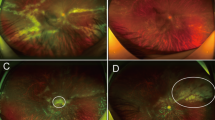Abstract
Background
To evaluate the efficacy of suppressing a recurrence of Toxoplasma retinochoroiditis after treatment with atovaquone.
Methods
Retrospective, nonrandomized, clinical trial. Forty-one immunocompetent patients were treated for Toxoplasma retinochoroiditis with atovaquone between 1999 and 2006. The diagnosis was based on clinical signs alone. Atovaquone was given 750 mg two to three times daily together with oral steroids. Lesion location, time interval until recurrence, visual function, and adverse events were recorded.
Results
Forty-two eyes of 41 patients were treated with atovaquone for Toxoplasma retinochoroiditis. Side-effects were usually mild and only one patient stopped therapy with atovaquone because of nausea. Reactivation of retinochoroiditis occurred in 18 patients (44%) during a time interval of 3–70 months.
Conclusions
The therapy of Toxoplasma retinochoroiditis with atovaquone is well tolerated. Our data suggests that therapy with atovaquone has the potential to prolong the time to recurrence of Toxoplasma retinochoroiditis. A prospective randomized comparative long-term clinical trial would be necessary to confirm our data.



Similar content being viewed by others
References
Wilder HC (1952) Toxoplasma chorioretinitis in adults. Arch Ophthalmol 48:127–136
Rothova A, Meenken C, Buitenhuis HJ (1993) Therapy for ocular toxoplasmosis. Am J Ophthalmol 115:517–523
Acers TE (1964) Toxoplasmic retinochoroiditis: a double-blind therapeutic study. Arch Ophthalmol 71:58–62
Stanford MR, See SE, Jones LV (2003) Antibiotics for toxoplasmic retinochoroiditis: an evidence-based systemic review. Ophthalmology 110:926–931
Holland GN, O’Connor G, Belfort R Jr, Remington JS (2003) Ocular toxoplasmosis: a global reassessment. Part I: Epidemiology and course of disease. Am J Ophthalmol 136:973–988
Garweg JG, Scherrer JN, Halberstad M (2008) Recurrence characteristics in European patients with ocular toxoplasmosis. BJO 92(9):1253–1256
Bosch-Driessen L, Berendschot T, Ongkosuwito J, Rothova A (2002) Ocular toxoplasmosis—clinical features and prognosis of 154 patients. Ophthalmology 109(5):869–878
Huskinson-Mark J, Araujo FG, Remington JS (1991) Evaluation of the effect of drugs on the cyst form of Toxoplasma gondii. J Infect Dis 164:170–177
Rothova A, Bosch-Driessen E, van Loon NH, Treffers WF (1998) Azithromycin for ocular toxoplasmosis. Br J Ophthalmol 82:1306–1308
Gormley PD, Pavesio CE, Minnasian D, Lightman S (1998) Effects of drug therapy on toxoplasma cysts in an animal model of acute and chronic disease. Invest Ophthalmol Vis Sci 39:1171–1175
Pearson PA, Piracha AR, Sen HA, Jaffe GJ (1999) Atovaquone for the treatment of toxoplasma retinochoroiditis in immunocompetent patients. Ophthalmology 106(1):148–153
Holland GN, O’Connor GR, Belfort R Jr, Remington JS (1996) Ocular infection and immunity. Mosby-Year Book, St. Louis, pp 1183–1223
Holland G, Crespi CM, Dam-van Loon N et al (2008) Analysis of recurrence patterns associated with toxoplasmic retinochoroiditis. Am J Ophthalmol 145(6):1007–1013
Tugal-Tutkun I, Corum I, Ötük B, Urgancioglu M (2005) Active ocular toxoplasmosis in Turkish patients: a report on 109 cases. Int Ophthalmol 26:221–228
Rolan PE, Mercer AJ, Weatherley BC (1994) Examination of some factors responsible for a food-induced increase in absorption of atovaquone. Br J Clin Pharmacol 37:13–20
Pleyer U, Torun N, Liesenfeld O (2007) Okuläre Toxoplasmose. Der Ophthalmologe 104:603–616
Bosch-Driessen EH, Rothova A (1998) Sense and nonsense of corticosteroid administration in the treatment of ocular toxoplasmosis. Br J Ophthalmol 82(8):858–860
Hofflin JM, Conley FK, Remington JS (1987) Murine model of intracerebral toxoplasmosis. J Infect Dis 155:550–556
Durrani OM, Meeds CA, Murray PI (2004) Uveitis: a potentially blinding disease. Opththalmologica 218(4):223–236
Krumpaszky HG, Klauß V, Kloske G (1992) Soziale Kosten von Sehbehinderung und Blindheit. Rehabilitationsangebot für die Betroffenen Klin Mbl Augenheilk 201:370–374
Author information
Authors and Affiliations
Corresponding author
Rights and permissions
About this article
Cite this article
Winterhalter, S., Severing, K., Stammen, J. et al. Does atovaquone prolong the disease-free interval of toxoplasmic retinochoroiditis?. Graefes Arch Clin Exp Ophthalmol 248, 1187–1192 (2010). https://doi.org/10.1007/s00417-010-1379-9
Received:
Revised:
Accepted:
Published:
Issue Date:
DOI: https://doi.org/10.1007/s00417-010-1379-9




